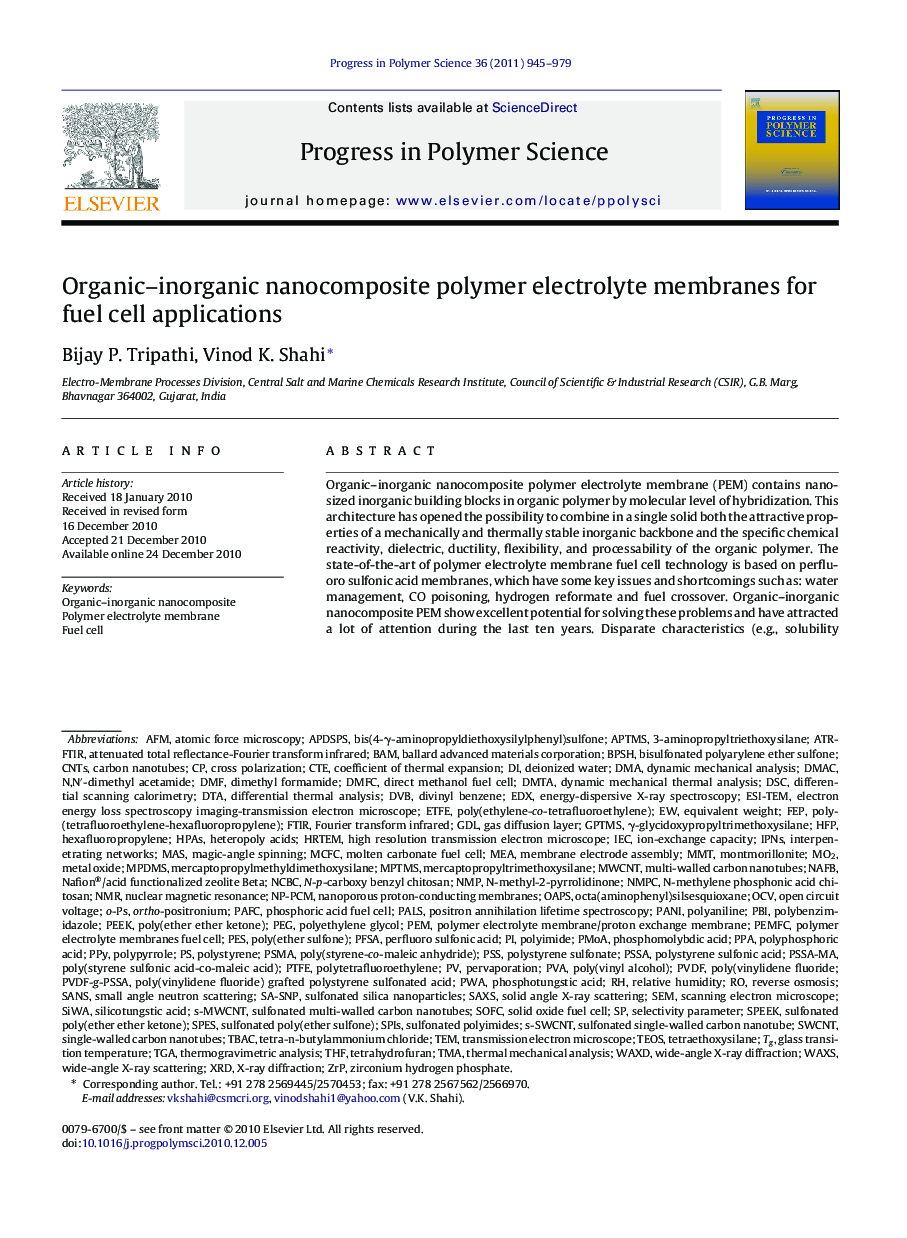| Article ID | Journal | Published Year | Pages | File Type |
|---|---|---|---|---|
| 5208509 | Progress in Polymer Science | 2011 | 35 Pages |
Abstract
Organic-inorganic nanocomposite polymer electrolyte membrane (PEM) contains nano-sized inorganic building blocks in organic polymer by molecular level of hybridization. This architecture has opened the possibility to combine in a single solid both the attractive properties of a mechanically and thermally stable inorganic backbone and the specific chemical reactivity, dielectric, ductility, flexibility, and processability of the organic polymer. The state-of-the-art of polymer electrolyte membrane fuel cell technology is based on perfluoro sulfonic acid membranes, which have some key issues and shortcomings such as: water management, CO poisoning, hydrogen reformate and fuel crossover. Organic-inorganic nanocomposite PEM show excellent potential for solving these problems and have attracted a lot of attention during the last ten years. Disparate characteristics (e.g., solubility and thermal stability) of the two components, provide potential barriers towards convenient membrane preparation strategies, but recent research demonstrates relatively simple processes for developing highly efficient nanocomposite PEMs. Objectives for the development of organic-inorganic nanocomposite PEM reported in the literature include several modifications: (1) improving the self-humidification of the membrane; (2) reducing the electro-osmotic drag and fuel crossover; (3) improving the mechanical and thermal strengths without deteriorating proton conductivity; (4) enhancing the proton conductivity by introducing solid inorganic proton conductors; and (5) achieving slow drying PEMs with high water retention capability. Research carried out during the last decade on this topic can be divided into four categories: (i) doping inorganic proton conductors in PEMs; (ii) nanocomposites by sol-gel method; (iii) covalently bonded inorganic segments with organic polymer chains; and (iv) acid-base PEM nanocomposites. The purpose here is to summarize the state-of-the-art in the development of organic-inorganic nanocomposite PEMs for fuel cell applications.
Keywords
AFMPVADSCDMFMEAMCFCTEOSPTFECTESOFCCNTSPEMFCDMADMFcTGAEDXHRTEMDVBPolypyrroleMWCNTSWCNTPSSTHFPVDFPEMPPytetraethoxysilaneATR-FTIRPESDTATMAPWAZRPMO2MMTPPAPBIWAXSPSMANMPFEPDMACHPAspmoADMTAWAXDGDLGPTMSγ-glycidoxypropyltrimethoxysilaneAPTMSNMPCETFEN-methyl-2-pyrrolidinoneOCVPSSAMPTMSTBACEquivalent weightPFSAOAPSPAFCPVDF-g-PSSASAXStetra-n-butylammonium chlorideHFPo-Psnuclear magnetic resonance3-aminopropyltriethoxysilaneSPESIPNsPANIsPEEKdeionized waterDifferential Thermal AnalysisOrtho-positroniumReverse OsmosisSilicotungstic acidPhosphotungstic acidPolyphosphoric acidHeteropoly acidsEnergy-Dispersive X-ray SpectroscopyMetal oxideTemSANSBAMMASFourier transform infraredTetrahydrofuranThermogravimetric analysisDynamic mechanical thermal analysisThermal mechanical analysisDynamic mechanical analysisPervaporationNMRglass transition temperaturedimethyl formamidedivinyl benzeneRelative humidityPEEKMolten carbonate fuel cellPhosphoric acid fuel cellsolid oxide fuel cellInterpenetrating networksCoefficient of Thermal ExpansionFTIRPositron Annihilation Lifetime SpectroscopyIon-exchange capacityPolymer electrolyte membranePhosphomolybdic acidGas diffusion layerattenuated total reflectance-Fourier transform infraredSEMMercaptopropyltrimethoxysilaneMontmorillonitemembrane electrode assemblyscanning electron microscopeTransmission electron microscopehigh resolution transmission electron microscopeatomic force microscopySingle-walled Carbon NanotubesMulti-walled carbon nanotubesCarbon nanotubesHexafluoropropyleneZirconium hydrogen phosphateopen circuit voltagePALSXRDX-ray diffractionWide-angle X-ray diffractionWide-angle X-ray scatteringsmall angle neutron scatteringCross polarizationPoly(ether ether ketone)Poly(styrene sulfonic acid-co-maleic acid)Poly(styrene-co-maleic anhydride)Sulfonated polyimidesPolyanilinePoly(ether sulfone)Sulfonated poly(ether sulfone)polyethylene glycolPolystyrene sulfonatePolystyrene sulfonic acidPolyimidePolybenzimidazolepolytetrafluoroethylenePoly(vinyl alcohol)Sulfonated poly(ether ether ketone)PEGPolystyrenefuel celldirect methanol fuel cellmagic-angle spinningDifferential scanning calorimetryIEC
Related Topics
Physical Sciences and Engineering
Chemistry
Organic Chemistry
Authors
Bijay P. Tripathi, Vinod K. Shahi,
